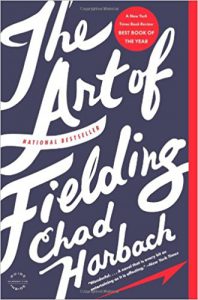The Art of Fielding, by Chad Harbach
The Art of Fielding
By Chad Harbach
Little, Brown
Five Stars
Reviewed by Jessica Gribble
Two chapters into The Art of Fielding, you start to think, “How can a first novel be this good?” The pace is perfect, the characters are both idiosyncratic and completely believable, and the emotions feel true throughout. Oh, yeah, and there’s baseball. As one of those people who thinks baseball is boring because the pitcher spends so much time on the mound trying to psych out the batter, I was hoping that Chad Harbach would convince me otherwise. And he absolutely did. I could see Henry’s grace on the field and hear Schwartzy’s knees creaking. I rooted for the Harpooners during games, but even more in the locker room, on the practice field, and during workouts.
The story begins with Henry Skrimshander, a puny high-school shortstop who can’t afford college. However, he’s extraordinarily good at baseball, a natural with his glove. Henry’s feelings about baseball are exemplified by a book he’s read too many times to count: The Art of Fielding, by the record-breaking shortstop Aparicio Rodriguez. It’s an Art of Motorcycle Maintenance for baseball, more concerned with the zen of the game than the details. Henry meets catcher Mike Schwartz at a summer league game, and Schwartz pulls some strings to get Henry into Westish College, where the team has been crappy forever. Schwartz tells Henry he’s going to turn it around. He spends much of the rest of the book making Henry his disciple, making him run up and down the stairs of the stadium, do pullups, lift weights, and learn to bat with power. Henry thrives under Schwartzy’s tutelage.
Guert Affenlight, while an undergrad at Westish, found some of Herman Melville’s unpublished papers. He became a Melville scholar, and when his alma mater called to offer him the presidency, he knew he’d come home. His daughter Pella, with whom he’s always been close, arrives at Westish when she leaves her husband. Affenlight is thus in his element, with his precious (albeit rootless) daughter living with him and his beloved college surrounding him. But then he falls in love with Owen Dunne, Henry’s gay roommate and teammate. As Pella struggles to build her new life, Guert struggles to make sense of his newly invigorated one. And to keep it from Pella and the other students. Then an errant throw of Henry’s changes everything, for himself, Owen, Schwartz, Pella, and Guert.
In this literary novel, whose characters care about the truth behind sports, books, and the most powerful human emotions, this turning point offers an opportunity to watch people respond to events out of their control. In the hands of a gifted writer like Harbach, it reads like this: “Affenlight felt something young well up in his chest, a thudding pain interspersed with something sweet, as if he were being dragged by an oxcart through a field of clover.”
At the beginning of the book, I had one complaint: that the names were such an obvious marker of status. The Westish College Harpooners. Guert Affelight, the president. Henry Skrimshander, the scrappy but driven outsider. Mike Schwartz, the jock. Owen Dunne is gay. By the end of the book, Harbach’s incredible talents had overwhelmed my petty concerns. The ambiance of the book, not at all harmed by the names, is both erudite and earthy.
If you’ve read Tom Wolfe’s I Am Charlotte Simmons, you know what a pompous, obviously-researched-by-talking-with-hip-confused-young-adults (but funny, vibrant, and at times brilliant) college novel is like. Once you’ve read The Art of Fielding, you’ll know what it’s like when a writer narrates a college and a baseball team so honestly you can’t believe it’s not real.
